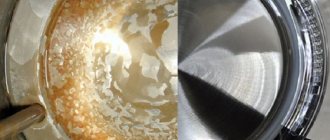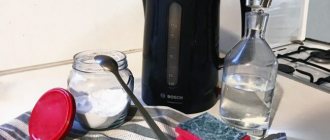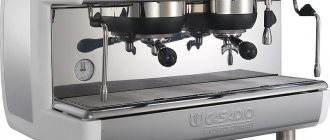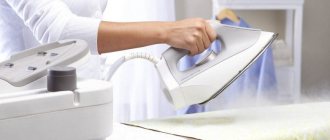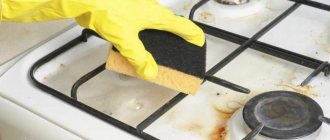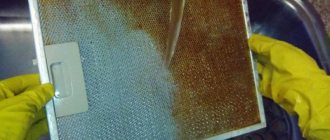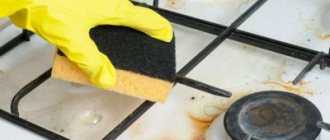Almost every person has encountered the problem of scale formation in an electric kettle and other electrical appliances, including a coffee machine. Over time, dense lime deposits begin to appear on the heating elements of the unit, which are difficult to remove with ordinary water. Cleaning the coffee machine with citric acid will allow you to get rid of scale as quickly and effectively as possible, without exposing the functional mechanisms of the unit to the harmful effects of aggressive chemicals and extend its service life without the need for repairs.
Why descale your coffee machine?
Pure water contains a large number of chemical elements such as calcium, magnesium, iron, potassium and chlorine, which when heated turn into lime, which settles on the heating elements of the machine. During the preparation of coffee, it flakes off and enters the drink in the form of white flakes, which make it unpresentable in appearance and tasteless. Scale also causes corrosion of various internal parts of the unit and leads to their premature failure. In addition, its porous structure promotes the proliferation of microorganisms and pathogenic bacteria.
Limescale, which accumulates inside the container and on the heating elements of the unit, forms a large layer of lime, which creates thermal resistance and worsens the thermal conductivity characteristics of the metal. This significantly increases the load on the electric heater and affects the length of time it takes to prepare the drink.
Most of the plaque is formed by calcium, so the procedure for cleaning a coffee machine is also called decalcification.
Signs indicating the need to clean the unit:
- the smell of coffee has changed (a musty feeling has appeared);
- the drink is not strong enough or is not fully brewed;
- steam pressure decreased significantly;
- During operation of the unit, uncharacteristic sounds are heard.
Some devices are equipped with special indicators for automatic control of scale. If a red light comes on on the device’s display or a corresponding message appears, it’s time to clean the coffee machine.
What are the consequences if you don’t clean it?
If descaling is not carried out at the specified time, parts may be damaged by corrosion.
The drinks themselves created by the coffee machine begin to lose their taste . In this case, the drink not only acquires an unpleasant aftertaste, but can also be harmful to health. This is due to the fact that lime deposits create a favorable environment for the development of pathogens.
At the same time, the thermal conductivity of the heating element deteriorates, the components begin to malfunction, and their functionality is impaired. As a result, the coffee machine itself begins to work worse, and the drink becomes less and less tasty. Over time, the device will require expensive repairs.
Is it permissible to clean a coffee machine with citric acid?
Today, many modern manufacturers offer a large number of different cleaning agents for coffee machines of different brands. But the best natural product for cleaning the unit is citric acid powder, which is sold in bags, as it has many benefits:
- it is safe for the human body;
- can effectively remove even old layers of scale;
- does not emit toxic substances during heating;
- environmentally friendly and does not harm the environment;
- cheaper than specialized products;
- can be purchased at any store.
How scale appears
Any drinking water, even bottled or filtered, contains a certain amount of dissolved salts, mainly calcium, magnesium, and iron compounds.
When water is heated to a boil, some of the salts precipitate , which accumulates on the walls of the coffee machine, forming scale, which leads to wear of parts and breakdown of the device. Over time, this layer becomes thicker and denser. The rate of formation of the limescale layer depends on the concentration of salt in the water.
The harder the water, the more often you will have to clean the coffee machine to remove scale.
Cleaning the coffee machine with citric acid
To effectively descale the unit, you must fully read the manufacturer's instructions and follow its recommendations. When preparing a solution of citric acid, you must strictly observe the specified proportions and strictly follow the developed algorithm for the procedure.
Amount of citric acid
Many people think that descaling a coffee machine will be most effective if descaling is carried out with a large amount of citric acid. But too high a concentration of powder can lead to damage to the internal elements of the unit. Therefore, the solution is prepared in compliance with the following proportions:
- for regular cleaning of the coffee machine, dilute 25-30 g of citric acid in 1 liter of water;
- To decalcify a heavily contaminated unit, make the solution more concentrated by adding water and 45-50 g of lemon powder.
You can buy citric acid at any grocery store or supermarket.
Dilution of citric acid
To prepare the cleaning solution, you need to heat the required volume of water to room temperature, pour the specified amount of citric acid into it and mix thoroughly.
The amount of water is taken in accordance with the manufacturer’s recommendations, which are indicated in the operating instructions for the coffee machine.
Cleaning process
Typically, decalcification of a coffee machine lasts about 30-40 minutes and consists of the following steps:
- descaling;
- first rinse mode;
- second rinse mode.
The procedure for decalcification:
- First, you need to de-energize the unit (remove the plug from the electrical outlet).
- Remove the reservoir and rinse it several times with a strong stream of running water.
- Pour the prepared solution into it and install it back into the unit.
- Connect the coffee machine to the mains and select the automatic cleaning option. If this option is not available, leave the solution in the container for 20 minutes and then press the coffee button.
- Repeat the process until the entire volume of the solution is used up by the device.
- Then turn off the power to the unit, remove the tank and rinse it well under running water.
- Carefully inspect the walls of the container: if scale remains on them, repeat the procedure.
- Fill the tank with purified water to the maximum allowable level and turn on the coffee brewing function (no need to add beans).
- Repeat the rinsing process of the unit one more time.
If everything is done correctly, the coffee machine will be completely descaled, and you will be able to drink coffee made from clean and tasty water.
What is decalcification of a coffee machine
Hard water contains large amounts of calcium salts. They form a loose film on the walls of the coffee machine, which attaches to itself the salts of other metals contained in the water. Decalcification is the process of removing salt deposits.
Mechanical descaling using cleaning pastes containing abrasive particles causes serious damage to the elements of the coffee machine and can lead to serious damage. Therefore, to decalcify and clean coffee machines from coffee oils, special compositions are used that contain substances that soften and remove the scale layer.
Coffee beans contain vegetable oil, which turns into liquid form when heated . After cooling, drops of oil become thicker and accumulate on the internal elements of the coffee machine. Over time, like any other oil, it becomes rancid, giving the coffee an unpleasant taste.
Precautionary measures
Before cleaning the coffee machine, you must read the manufacturer's instructions, which indicate the frequency of the decalcification process. When cleaning the unit, all safety precautions should be observed:
- Before carrying out the procedure, you must disconnect the device from the power supply;
- For cleaning, use only products approved by the manufacturer;
- do not use concentrated solutions that may adversely affect the operation of internal elements;
- Avoid getting water on the internal parts of the coffee machine so that a short circuit does not occur after turning it on.
Industrial products for cleaning coffee machines
Almost all serious manufacturers of modern coffee machines offer various special products for cleaning coffee machines. They are not cheap, but they guarantee high-quality results that extend the life of the device. The most famous among them are descaling liquids Saeco, DeLonghi, Melitta. Bosh offers a descaling agent for coffee machines in the form of tablets based on an active acid. You can clean your car using just one tablet.
Purchasing a branded cleaning product is justified if you use a high-end coffee machine, for example, Saeko, Delonghi or Bosch. The fine settings of these devices may be lost when using descaling products produced by unknown companies.
In all other cases, it is possible to use universal products, since their composition is approximately the same.
Preventive cleaning of the coffee machine can also be carried out after a certain number of coffees have been prepared.
Pollution prevention
In order to reduce the amount of scale and reduce the number of procedures to remove it, experts recommend using only bottled or purified water with a low degree of hardness.
In addition, adjustments should be made to the water hardness setting system, since otherwise the device will signal too often (or very rarely) that the decalcification process is necessary.
Also, the use of purified water will be an effective prevention for units that are equipped with a built-in filtration system, since it is sometimes not enough to protect the important components of the coffee machine from the appearance of lime deposits.
Regardless of the configuration, technical characteristics and functionality of the coffee machine, it is recommended to decalcify it with citric acid or other special means at least once a year. This will not only help get rid of scale, but will also significantly extend the life of the household appliance.
When to clean
If the coffee machine is equipped with a special sensor that notifies about the need for cleaning, then if the owner forgets, its operation is simply blocked. In the absence of such a signaling device, you should pay attention to the following malfunctions:
- the stream of coffee pouring into the cup becomes thinner;
- the sound of the coffee machine running becomes louder and a humming sound appears;
- limescale remains at the bottom of the cup;
- the milk foam becomes less dense and fluffy, its whipping time increases;
- Water begins to leak into the pan.
Preventative cleaning of the coffee machine can also be carried out after a certain number of prepared servings of coffee: for soft water - after 200-250 cups, for medium-hard water - 150-200, for hard water - 100-150 cups of coffee. Or according to another calculation: once every two months - for hard water, once every six months - for soft water.
If the intensity of use of the coffee maker and electric kettle is approximately the same, you can focus on the formation of scale on the walls of the unit. Its appearance indicates that it is time to clean the coffee machine.


